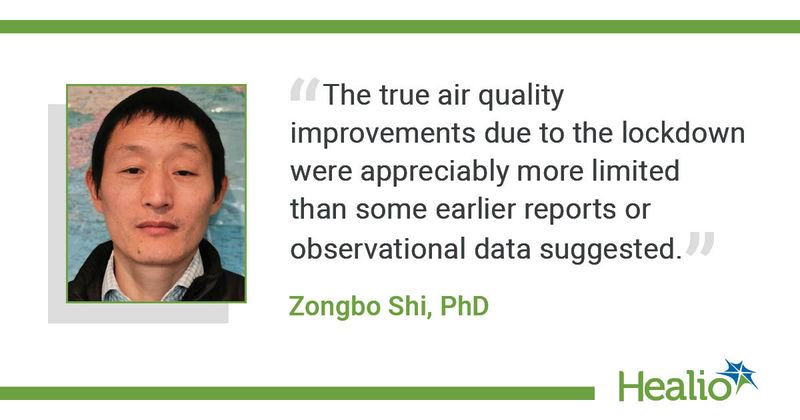Q&A: COVID-19 lockdowns affected air pollution less than expected
COVID-19 lockdowns in several cities affected air pollution less than expected, according to a study published in Science.
Zongbo Shi, PhD, professor of atmospheric biogeochemistry at the University of Birmingham, and colleagues used a weather normalization method to isolate changes in air pollutant concentrations and evaluate air quality impacts from lockdown zones in 11 cities: Beijing and Wuhan, China; Milan; Rome; Madrid; London; Paris; Berlin; New York; Los Angeles; and Delhi, India.

They found that, although reductions in automobile use during lockdowns led to a decrease in NO2 for all cities, only 30% of the decline could be attributed to the effects of the lockdown. This change was likely due to sustained emissions from other sources of pollution, they wrote.
We spoke with Shi about the implications of the study.
Q: What factors contributed to overestimation of air quality changes during lockdowns?
A: There are two main factors. The first one is meteorology, which affects pollution levels, driving dispersion of local emissions and transporting pollutants from upwind. The second one is seasonal changes in air pollution levels due to changes in emissions and chemistry — for example, as combustion for heating decreases from winter into the spring, and changes in atmospheric processing occur as temperature and sunlight increase. These factors can make air pollutant concentration change on either side of a given date — for example, the start of a lockdown — higher or lower than the actual emissions change, for example, due to the lockdowns.
Q: Can we expect air quality to return to pre-pandemic levels once lockdowns are lifted?
A: The pandemic has changed the way we work and do business. This has potential beneficial effects on air quality. For example, with more people working at home, traffic emissions are likely going to be lower in the future than they were at pre-lockdown levels. In some cities, there are also clean air actions in place, so air pollution levels decline year by year, such as in Beijing. Therefore, it is more likely that air pollution levels will be lower in the future, unless there is a sudden increase in economic activities, like industrial production, in those cities.
Q: Aside from the influence of people during lockdown, are there other factors that may have affected air quality?
A: In addition to human factors, which affect air pollution emissions, meteorological conditions and atmospheric chemistry both contribute to changes in air quality. Meteorological conditions influence the dispersion of air pollutants, as mentioned earlier. Atmospheric chemistry regulates chemical reactions in the air, which form secondary pollutants such as ozone and fine particles. This is why we saw an increase in ozone when air pollutant emissions reduced during the lockdown. At most locations, a certain amount of ozone is present in background air. Road traffic emissions of NO remove some of this O3 — the reaction is NO + O3 creates NO2 + O2. So, less traffic leads to less NO emission and less O3 reduction. This is a quick atmospheric process, taking place over a minute or so and affecting local O3 levels. The slower atmospheric reactions that form O3 over the course of several days are also affected by the changed emissions.
Q: Are there other areas of research related to this topic that are worth exploring further?
A: There are two areas of research that are worth exploring further. The first is, “What are the underlying physical and chemical processes responsible for the increase in secondary pollutants, such as ozone and secondary PM2.5 during the lockdowns in London and Paris?” The second is, “How do we maximize health benefits of air quality improvement by coordinating the control of all major air pollutants such as NO2, O3 and PM2.5?”
Q: Are there implications from this study for air pollution mitigation efforts?
A: Our study shows that the true air quality improvements due to the lockdown were appreciably more limited than some earlier reports or observational data suggested — highlighting the scale of the challenge to clean up our air. The response of PM2.5 is complex and depends upon the individual city. Therefore, a systematic approach to air pollution control, tailed to each specific city and considering all pollutant species, would be needed to deliver the greatest health benefits.
In some ways, the lockdowns allow us to see into the future. The steep changes in NO2 in U.K. cities during lockdown are the same as those expected by 2027 to 2030 due to changes in vehicle emissions (fleet renewal and electrification) to meet the climate challenge. Although atmospheric CO2 mixes globally, pollutants like NO2 last a day or so in the air, and so remain close to their emission location. Lockdown shows us that some changes to reduce carbon emissions — driven by global climate change, an international issue — will also bring immediate local benefits for our air quality and our health.

